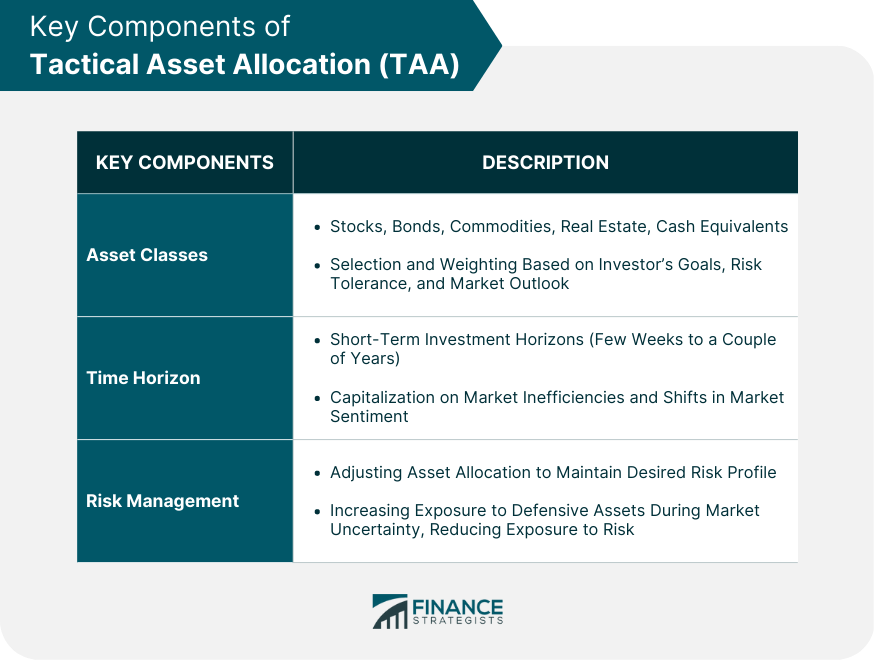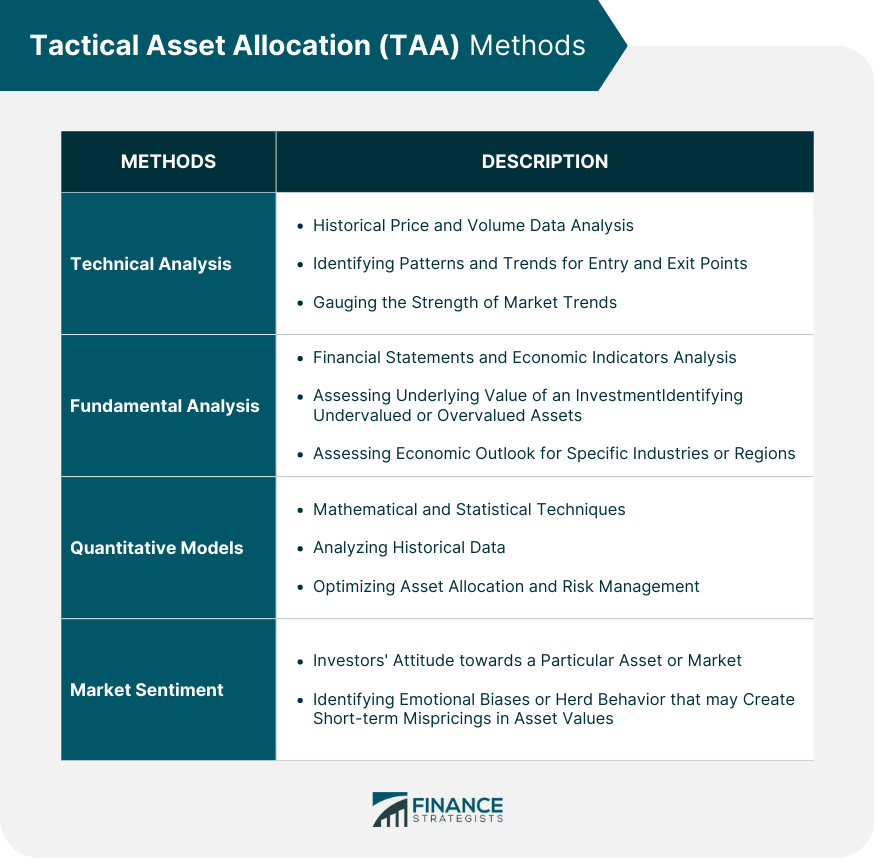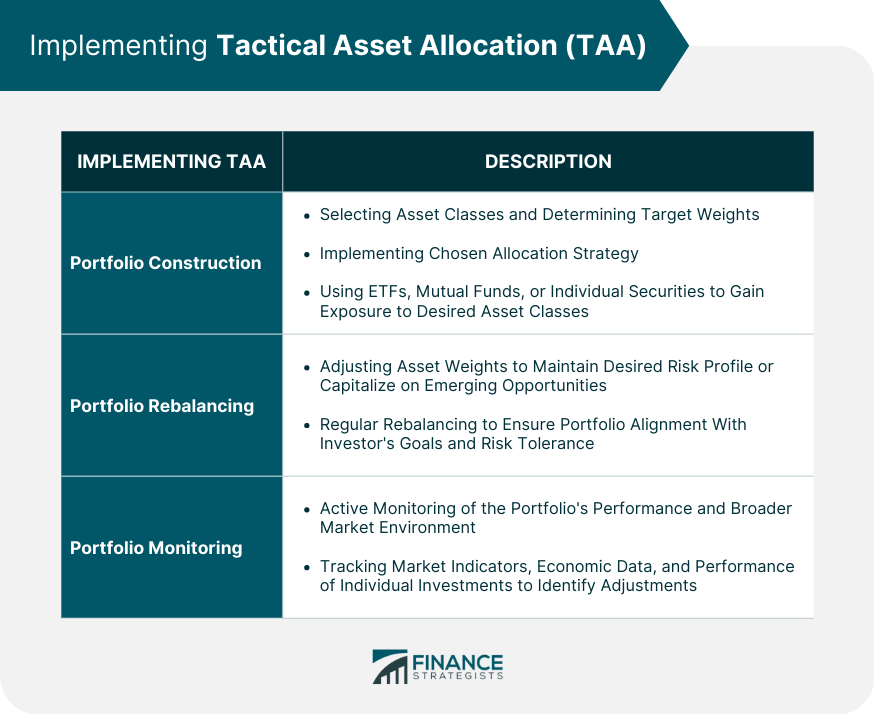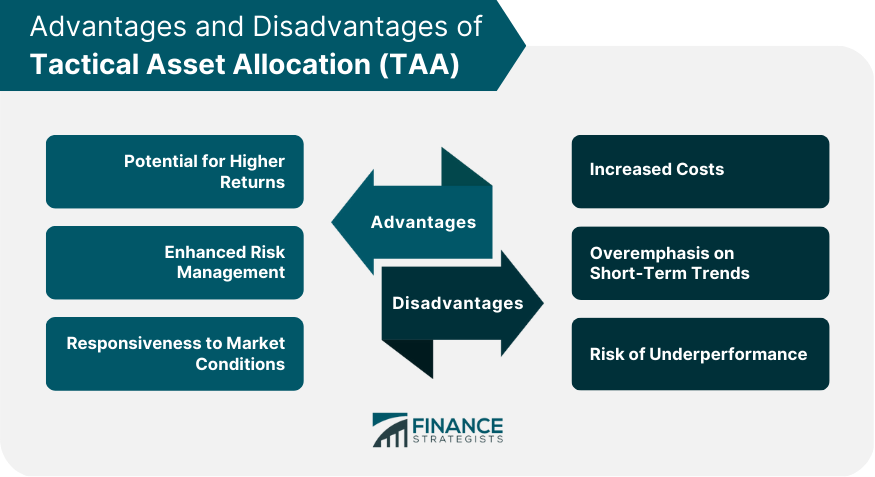Tactical Asset Allocation aims to outperform the market by temporarily adjusting a portfolio's asset mix based on market conditions. This approach seeks to capitalize on market inefficiencies or irregularities to generate excess returns or reduce risk. This strategy is more flexible and responsive to short-term market movements compared to Strategic Asset Allocation (SAA), which focuses on a long-term, fixed asset allocation plan. While both TAA and SAA involve diversifying investments across various asset classes, TAA emphasizes active management and frequent adjustments in response to changing market conditions. On the other hand, SAA emphasizes a long-term, buy-and-hold approach based on an investor's risk tolerance and financial goals. TAA can be applied to various asset classes, including stocks, bonds, commodities, real estate, and cash equivalents. The selection and weighting of these asset classes depending on an investor's goals, risk tolerance, and market outlook. TAA focuses on short-term investment horizons, typically ranging from a few weeks to a couple of years. This shorter timeframe allows investors to capitalize on market inefficiencies or shifts in market sentiment more effectively than a long-term strategy like SAA. An essential aspect of TAA is managing risk by adjusting the allocation of assets to maintain a desired risk profile. This can involve increasing exposure to defensive assets during periods of market uncertainty or reducing exposure to risky assets when market valuations appear stretched. The following are the different TAA methods: Technical analysis involves studying historical price and volume data to identify patterns and trends that may provide insights into future price movements. This method can be used in TAA to determine entry and exit points for different asset classes and gauge the strength of market trends. Fundamental analysis focuses on assessing the underlying value of an investment by examining financial statements, economic indicators, and other qualitative factors. In the context of TAA, fundamental analysis can be used to identify undervalued or overvalued assets and assess the economic outlook for specific industries or regions. Quantitative models use mathematical and statistical techniques to analyze historical data and identify patterns or relationships that may be useful for predicting future market behavior. These models can be incorporated into TAA to optimize asset allocation and risk management. Market sentiment refers to the overall attitude of investors towards a particular asset or market. By gauging market sentiment, TAA practitioners can identify and exploit emotional biases or herd behavior that may create short-term mispricings in asset values. Building a TAA portfolio involves selecting the appropriate asset classes, determining their target weights, and implementing the chosen allocation strategy. This process may include using exchange-traded funds (ETFs), mutual funds, or individual securities to gain exposure to the desired asset classes. Rebalancing is an essential aspect of TAA, as it involves adjusting the portfolio's asset weights to maintain the desired risk profile or capitalize on emerging opportunities. Regular rebalancing can help ensure the portfolio remains aligned with the investor's goals and risk tolerance. Active monitoring of the portfolio's performance and the broader market environment is critical for successful TAA implementation. This process may involve tracking market indicators, economic data, and the performance of individual investments to identify potential adjustments to the portfolio's asset allocation. Potential for Higher Returns: TAA can generate excess returns by capitalizing on short-term market inefficiencies and adjusting the portfolio to exploit emerging opportunities. Enhanced Risk Management: By actively managing the asset mix, TAA can help maintain the desired risk profile and protect against downside risks during periods of market stress. Responsiveness to Market Conditions: TAA's flexibility allows investors to adapt their portfolios to shifting market conditions, which can be particularly beneficial during periods of increased market volatility. Increased Costs: Frequent trading and portfolio adjustments can lead to higher transaction costs and taxes, which may offset the potential benefits of TAA. Overemphasis on Short-Term Trends: TAA's focus on short-term market movements may cause investors to overlook long-term investment opportunities or fundamentals. Risk of Underperformance: Active management can introduce the possibility of underperformance if the investor's market forecasts or tactical decisions prove incorrect. The following are example of case studies on TAA: In a bull market, TAA can help investors capitalize on the strong performance of growth-oriented assets, such as stocks or high-yield bonds, by overweighting these asset classes and reducing exposure to defensive assets like cash or government bonds. TAA can provide downside protection during a bear market by reallocating assets to more defensive investments, such as cash or high-quality bonds. This defensive posture can help limit portfolio losses and preserve capital when market conditions improve. TAA can also be beneficial during periods of market volatility by dynamically adjusting the portfolio to take advantage of short-term market dislocations or shifts in market sentiment. This responsiveness can help investors navigate uncertain market environments and potentially generate excess returns. The following are the tools and resources for TAA: Several software platforms and tools are available to help investors implement TAA strategies, including portfolio management systems, trading platforms, and risk analytics tools. These resources can assist with portfolio construction, rebalancing, and performance monitoring. Investors can access various research and data sources to inform their TAA decisions, including market and economic data providers, financial news outlets, and research reports from investment banks or independent research firms. Investors may also consider working with financial advisors, asset managers, or robo-advisors specializing in TAA strategies. These professionals can provide guidance and support in implementing and managing TAA portfolios and help with ongoing portfolio monitoring and adjustments. Before adopting TAA, investors should carefully consider their investment goals, risk tolerance, and time horizon. TAA may be more suitable for investors who are comfortable with active management, have a higher risk tolerance, and seek to generate excess returns through short-term market opportunities. Understanding the potential benefits and drawbacks of TAA before incorporating it into your investment strategy is essential. While TAA can offer the potential for higher returns and improved risk management, it also comes with increased costs, the risk of underperformance, and a focus on short-term market trends. If you determine that TAA is appropriate for your investment goals and risk tolerance, consider incorporating it as a complementary approach within your broader investment strategy. This could involve allocating a portion of your portfolio to TAA while maintaining a long-term strategic asset allocation for the remainder. This hybrid approach can help you capture the potential benefits of TAA while mitigating some of the risks and challenges associated with active management. Tactical Asset Allocation is an active investment strategy that focuses on adjusting portfolio allocations based on short-term market trends and opportunities. This approach offers potential advantages, such as higher returns, enhanced risk management, and responsiveness to market conditions. However, it also comes with potential challenges, including increased costs, a focus on short-term trends, and the risk of underperformance. Before deciding to implement TAA in your investment strategy, it's essential to carefully consider your investment goals, risk tolerance, and time horizon. A hybrid approach that combines TAA with long-term strategic asset allocation can help you achieve a balanced and diversified investment strategy. If you are interested in exploring Tactical Asset Allocation further or require assistance in implementing this approach, you may seek professional wealth management services. A skilled financial advisor can guide you through the process, help you determine whether TAA suits your unique circumstances, and provide ongoing support in managing your investment portfolio.What Is a Tactical Asset Allocation (TAA)?
Key Components of Tactical Asset Allocation (TAA)
Asset Classes in Tactical Asset Allocation
Time Horizon for Tactical Asset Allocation
Tactical Asset Allocation Risk Management

Tactical Asset Allocation (TAA) Methods
TAA With Technical Analysis
TAA With Fundamental Analysis
TAA With Quantitative Models
TAA With Market Sentiment

Implementing Tactical Asset Allocation (TAA)
Portfolio Construction
Portfolio Rebalancing
Portfolio Monitoring

Advantages of Tactical Asset Allocation (TAA)
Disadvantages of Tactical Asset Allocation (TAA)

Case Studies: Successful Tactical Asset Allocation (TAA)
TAA in a Bull Market
TAA in a Bear Market
TAA During Market Volatility
Tools and Resources for Tactical Asset Allocation (TAA)
Software and Platforms
Research and Data Sources
Professional Assistance for TAA
Is Tactical Asset Allocation (TAA) Right for You?
Assessing Your Investment Goals and Risk Tolerance
Weighing the Pros and Cons of TAA
Integrating TAA Into Your Overall Investment Strategy
Final Thoughts
Tactical Asset Allocation (TAA) FAQs
Tactical Asset Allocation is an active investment strategy that involves adjusting the weights of different asset classes within a portfolio based on short-term market trends or opportunities. This approach aims to capitalize on market inefficiencies or irregularities to generate excess returns or reduce risk.
While both TAA and Strategic Asset Allocation (SAA) involve diversifying investments across various asset classes, TAA emphasizes active management and frequent adjustments in response to changing market conditions. In contrast, SAA focuses on a long-term, buy-and-hold approach based on an investor's risk tolerance and financial goals.
The key components of TAA include selecting appropriate asset classes (e.g., stocks, bonds, commodities, real estate, and cash equivalents), determining their target weights, managing risk, and implementing various methods, such as technical analysis, fundamental analysis, quantitative models, or market sentiment analysis.
The potential benefits of TAA include higher returns, enhanced risk management, and responsiveness to market conditions. However, the drawbacks may include increased costs, overemphasis on short-term trends, and the risk of underperformance if tactical decisions prove incorrect.
To implement TAA, you can start by building a portfolio that includes various asset classes, determining their target weights, and applying a chosen TAA method. Regularly rebalance and monitor the portfolio's performance to make necessary adjustments. You may also consider seeking professional wealth management services to help you effectively implement and manage a TAA strategy.
True Tamplin is a published author, public speaker, CEO of UpDigital, and founder of Finance Strategists.
True is a Certified Educator in Personal Finance (CEPF®), author of The Handy Financial Ratios Guide, a member of the Society for Advancing Business Editing and Writing, contributes to his financial education site, Finance Strategists, and has spoken to various financial communities such as the CFA Institute, as well as university students like his Alma mater, Biola University, where he received a bachelor of science in business and data analytics.
To learn more about True, visit his personal website or view his author profiles on Amazon, Nasdaq and Forbes.











